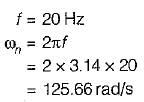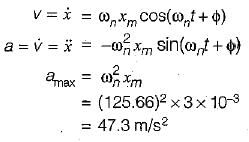Mechanical Engineering Exam > Mechanical Engineering Questions > What is the maximum acceleration of a particl...
Start Learning for Free
What is the maximum acceleration of a particle which moves in simple harmonic motion with an amplitude of 3 mm and frequency of 20 Hz?
- a)47 m/s2
- b)48 m/s2
- c)49 m/s2
- d)50 m/s2
Correct answer is option 'A'. Can you explain this answer?
| FREE This question is part of | Download PDF Attempt this Test |
Verified Answer
What is the maximum acceleration of a particle which moves in simple h...



Most Upvoted Answer
What is the maximum acceleration of a particle which moves in simple h...
Maximum Acceleration in Simple Harmonic Motion
In simple harmonic motion (SHM), the acceleration of a particle can be calculated using the equation:
a = -ω^2x
where a is the acceleration, ω is the angular frequency, and x is the displacement from the equilibrium position.
Given Data:
Amplitude (A) = 3 mm = 0.003 m
Frequency (f) = 20 Hz
Calculating Angular Frequency:
The angular frequency (ω) can be calculated using the formula:
ω = 2πf
Substituting the given frequency into the formula:
ω = 2π * 20 = 40π rad/s
Calculating Maximum Acceleration:
The maximum acceleration (amax) occurs when the particle is at maximum displacement, which is equal to the amplitude (A).
Substituting the values into the acceleration equation:
amax = -ω^2A
amax = -(40π)^2 * 0.003
amax = -1600π^2 * 0.003
amax ≈ -150.796 m/s^2
Since the acceleration is a vector quantity, the negative sign indicates that the acceleration is in the opposite direction to the displacement.
Converting to Positive Value:
To find the maximum positive acceleration, we can take the magnitude of the acceleration by removing the negative sign:
|amax| = 150.796 m/s^2
Rounding the value to the nearest whole number:
|amax| ≈ 151 m/s^2
Choosing the Correct Option:
Among the given options (a) 47 m/s^2, (b) 48 m/s^2, (c) 49 m/s^2, and (d) 50 m/s^2, the closest option to the calculated value of 151 m/s^2 is (a) 47 m/s^2.
Therefore, the correct answer is option 'A' - 47 m/s^2.
In simple harmonic motion (SHM), the acceleration of a particle can be calculated using the equation:
a = -ω^2x
where a is the acceleration, ω is the angular frequency, and x is the displacement from the equilibrium position.
Given Data:
Amplitude (A) = 3 mm = 0.003 m
Frequency (f) = 20 Hz
Calculating Angular Frequency:
The angular frequency (ω) can be calculated using the formula:
ω = 2πf
Substituting the given frequency into the formula:
ω = 2π * 20 = 40π rad/s
Calculating Maximum Acceleration:
The maximum acceleration (amax) occurs when the particle is at maximum displacement, which is equal to the amplitude (A).
Substituting the values into the acceleration equation:
amax = -ω^2A
amax = -(40π)^2 * 0.003
amax = -1600π^2 * 0.003
amax ≈ -150.796 m/s^2
Since the acceleration is a vector quantity, the negative sign indicates that the acceleration is in the opposite direction to the displacement.
Converting to Positive Value:
To find the maximum positive acceleration, we can take the magnitude of the acceleration by removing the negative sign:
|amax| = 150.796 m/s^2
Rounding the value to the nearest whole number:
|amax| ≈ 151 m/s^2
Choosing the Correct Option:
Among the given options (a) 47 m/s^2, (b) 48 m/s^2, (c) 49 m/s^2, and (d) 50 m/s^2, the closest option to the calculated value of 151 m/s^2 is (a) 47 m/s^2.
Therefore, the correct answer is option 'A' - 47 m/s^2.
Attention Mechanical Engineering Students!
To make sure you are not studying endlessly, EduRev has designed Mechanical Engineering study material, with Structured Courses, Videos, & Test Series. Plus get personalized analysis, doubt solving and improvement plans to achieve a great score in Mechanical Engineering.

|
Explore Courses for Mechanical Engineering exam
|

|
Similar Mechanical Engineering Doubts
What is the maximum acceleration of a particle which moves in simple harmonic motion with an amplitude of 3 mm and frequency of 20 Hz?a)47 m/s2b)48 m/s2c)49 m/s2d)50 m/s2Correct answer is option 'A'. Can you explain this answer?
Question Description
What is the maximum acceleration of a particle which moves in simple harmonic motion with an amplitude of 3 mm and frequency of 20 Hz?a)47 m/s2b)48 m/s2c)49 m/s2d)50 m/s2Correct answer is option 'A'. Can you explain this answer? for Mechanical Engineering 2024 is part of Mechanical Engineering preparation. The Question and answers have been prepared according to the Mechanical Engineering exam syllabus. Information about What is the maximum acceleration of a particle which moves in simple harmonic motion with an amplitude of 3 mm and frequency of 20 Hz?a)47 m/s2b)48 m/s2c)49 m/s2d)50 m/s2Correct answer is option 'A'. Can you explain this answer? covers all topics & solutions for Mechanical Engineering 2024 Exam. Find important definitions, questions, meanings, examples, exercises and tests below for What is the maximum acceleration of a particle which moves in simple harmonic motion with an amplitude of 3 mm and frequency of 20 Hz?a)47 m/s2b)48 m/s2c)49 m/s2d)50 m/s2Correct answer is option 'A'. Can you explain this answer?.
What is the maximum acceleration of a particle which moves in simple harmonic motion with an amplitude of 3 mm and frequency of 20 Hz?a)47 m/s2b)48 m/s2c)49 m/s2d)50 m/s2Correct answer is option 'A'. Can you explain this answer? for Mechanical Engineering 2024 is part of Mechanical Engineering preparation. The Question and answers have been prepared according to the Mechanical Engineering exam syllabus. Information about What is the maximum acceleration of a particle which moves in simple harmonic motion with an amplitude of 3 mm and frequency of 20 Hz?a)47 m/s2b)48 m/s2c)49 m/s2d)50 m/s2Correct answer is option 'A'. Can you explain this answer? covers all topics & solutions for Mechanical Engineering 2024 Exam. Find important definitions, questions, meanings, examples, exercises and tests below for What is the maximum acceleration of a particle which moves in simple harmonic motion with an amplitude of 3 mm and frequency of 20 Hz?a)47 m/s2b)48 m/s2c)49 m/s2d)50 m/s2Correct answer is option 'A'. Can you explain this answer?.
Solutions for What is the maximum acceleration of a particle which moves in simple harmonic motion with an amplitude of 3 mm and frequency of 20 Hz?a)47 m/s2b)48 m/s2c)49 m/s2d)50 m/s2Correct answer is option 'A'. Can you explain this answer? in English & in Hindi are available as part of our courses for Mechanical Engineering.
Download more important topics, notes, lectures and mock test series for Mechanical Engineering Exam by signing up for free.
Here you can find the meaning of What is the maximum acceleration of a particle which moves in simple harmonic motion with an amplitude of 3 mm and frequency of 20 Hz?a)47 m/s2b)48 m/s2c)49 m/s2d)50 m/s2Correct answer is option 'A'. Can you explain this answer? defined & explained in the simplest way possible. Besides giving the explanation of
What is the maximum acceleration of a particle which moves in simple harmonic motion with an amplitude of 3 mm and frequency of 20 Hz?a)47 m/s2b)48 m/s2c)49 m/s2d)50 m/s2Correct answer is option 'A'. Can you explain this answer?, a detailed solution for What is the maximum acceleration of a particle which moves in simple harmonic motion with an amplitude of 3 mm and frequency of 20 Hz?a)47 m/s2b)48 m/s2c)49 m/s2d)50 m/s2Correct answer is option 'A'. Can you explain this answer? has been provided alongside types of What is the maximum acceleration of a particle which moves in simple harmonic motion with an amplitude of 3 mm and frequency of 20 Hz?a)47 m/s2b)48 m/s2c)49 m/s2d)50 m/s2Correct answer is option 'A'. Can you explain this answer? theory, EduRev gives you an
ample number of questions to practice What is the maximum acceleration of a particle which moves in simple harmonic motion with an amplitude of 3 mm and frequency of 20 Hz?a)47 m/s2b)48 m/s2c)49 m/s2d)50 m/s2Correct answer is option 'A'. Can you explain this answer? tests, examples and also practice Mechanical Engineering tests.

|
Explore Courses for Mechanical Engineering exam
|

|
Suggested Free Tests
Signup for Free!
Signup to see your scores go up within 7 days! Learn & Practice with 1000+ FREE Notes, Videos & Tests.
























